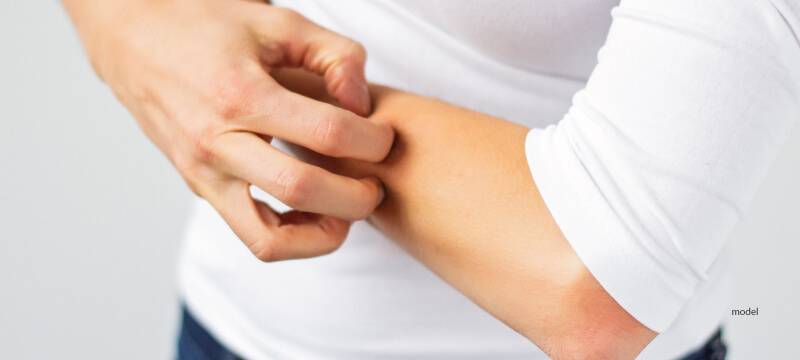List: The 9 Most Common Bacterial Skin Infections

Many types of bacteria are actually found all over human skin. Most of the time we live in symbiosis, however true bacterial infections of the skin can be seen both from our normal skin flora but also from bacteria not usually found on the skin. Fortunately, the typical skin infection is minor and resolves itself in a few days without needing any form of advanced treatment. However, there are some infections that, left untreated, can cause serious symptoms and be harmful to one’s health.
In this blog post, we’ll discuss the 9 most common bacterial skin infections, along with their symptoms. Keep reading to learn how to identify a bacterial infection and when you should seek professional medical care.
About Bacterial Skin Infections
Bacterial skin infections typically occur when bacteria enter the skin through broken skin, cuts, scrapes or scratches; or when your native bacteria over grows. Infection can occur even in the most minor cuts, such as pores aggravated by shaving. Bacterial skin infections often begin as small, raised, red bumps or pustules, and may increase in size over time. They aren’t always painful or warm to the touch.
While some infections are easily treated with topical antibiotics, more severe infections may require oral or even IV antibiotic treatment.
You’re more susceptible to bacterial skin infection if you have a weakened immune system due to illness or medication.
Symptoms of Bacterial Skin Infection
Bacterial skin infection may look like small lumps, or may appear as an oozing, infected cut or boil. Skin infections can seem similar to eczema or other skin conditions.
Below are some common symptoms to look for:
- Any fluid other than blood that leaks from your cut
- Yellow or cloudy pus or crust on the top of your cut
- Sores that look like blisters or pimples
- Swelling that increases over time
- Pain that increases over time
- Red skin surrounding your cut
- Red streaking or warmth to the area
- A wound that doesn’t heal
- A fever that accompanies your injury
The 9 Most Common Bacterial Infections
MRSA
MRSA, Methicillin-Resistant Staphylococcus Aureus, is the most serious form of staph infection. As the name implies, it’s resistant to certain antibiotic treatment. Symptoms differ but may include swelling, redness or pus. Typically these infections cause boils or abscesses, but if cellulitis occurs, then systemic illness can accompany it and may require hospitalization. MRSA is quite common and can spread in families and close contacts.
Impetigo
Impetigo, also known as school sores, is a highly contagious infection that’s more common in children than adults. The term impetigo simply means a bacterial infection, but often we see sores around the nose and mouth in children. This is usually caused by staph or strep.
Furuncle
A furuncle is better known as a large boil. This pus-filled bump typically forms around an infected hair follicle. As boils grow, they may rupture and drain on their own. Large boils, or those lasting longer than 2 weeks should be seen by a doctor.
Carbuncle
A carbuncle is a cluster of boils. While they may look separate above the skin, the infection under the skin may be connected. Large carbuncles may need to be drained by a doctor. Never attempt to drain a boil or carbuncle at home.
Hot-Tub Folliculitis
Pseudomonas Folliculitis is named for the place where it’s most likely to happen, in a pool or hot-tub. The itchy rash or pus-filled bumps often appear where your swimsuit holds water against your skin. It’s also common in children, who often stay in the water much longer than adults. Usually if your pH is correct you don’t have to worry about this! Although it is itchy, it often resolves by itself without any problems.
Folliculitis
This common infection of the hair follicles can be caused by bacteria or fungus. Shaving or plucking hairs increases the risk of folliculitis. The infection most commonly occurs when pores get blocked by ingrown hairs or aggravated by dry-shaving.
Erythrasma
Erythrasma is frequently mistaken for a fungal infection because it occurs in areas where skin touches skin, such as under arms, between toes or in the groin area. The infection initially appears as pink, wrinkly patches of skin which turn brown and scaly over time. Erythrasma is caused by Corynebacterium and can be treated by your dermatologist.
Cellulitis
Cellulitis occurs where skin has been broken or wounded and affects the deepest layers of the skin. It appears as a red, swollen area that’s often hot to the touch. Cellulitis is usually caused by the bacteria Staphylococcus or Streptococcus, the two most common types of bacteria found in skin infections. If left untreated, it may spread to the lymph nodes and become life-threatening.
Erysipelas
This bacterial skin infection is known as St. Anthony’s Fire for the severe burning sensation it causes. Infected tissue is red, swollen, and sharply differentiated from the surrounding skin. Fevers and chills can accompany this infection and it requires antibiotics. Erysipelas can arise from untreated athlete’s foot, a good reminder to take all skin infections seriously.
When to See A Doctor
If you think you have a skin infection and any of the following are true, call your doctor immediately:
- You’re experiencing extreme pain
- You have a fever of 100.4 of higher
- Redness or swelling around your infection is spreading
- Your infection has persisted for more than 2 weeks
Diagnosing Bacterial Skin Infections
Bacterial skin infections must be properly diagnosed for treatment to be effective. Your doctor will begin by inspecting the infected area and asking you questions about your symptoms. Next, a small skin scraping fluid sample from the infected may will be sent to a lab for testing.
Treating Bacterial Skin Infections
Most skin infections are easily treated with a topical antibiotic, applied to the skin as a spray, gel or cream. More stubborn infections may require oral antibiotics, while serious infections can require intravenous treatment in a hospital setting.
After a visit with your doctor, symptoms such as redness, swelling or itching can be relieved at home with the following methods:
- Apply an ice pack to the infected area several times per day
- Take an over-the-counter antihistamine to reduce swelling or itching
How to Prevent Bacterial Skin Infections
In general, skin infections are prevented by keeping your skin clean and dry. Adhering to the following simple advice can prevent a life-threatening situation.
- Wash hands frequently. Use warm water and soap and scrub for a minimum of 20 seconds. Use hand sanitizer when soap and water isn’t readily available.
- At the gym, wipe your equipment with sanitizer before and after use. Use a dry, clean towel as a barrier between your skin and the equipment. Shower and change into clean, dry clothes immediately after your workouts.
- If you have a cut, scrape, or wound, keep it clean and dry. Wash it with warm water and soap, then follow up with an over-the-counter antibiotic such as bacitracin.
- Post-surgery, follow your doctor’s wound care instructions closely. Avoid soaking wounds in water, keep bandages clean and dry.
Disclaimer: The contents of the Westlake Dermatology website, including text, graphics, and images, are for informational purposes only and are not intended to substitute for direct medical advice from your physician or other qualified professional.
